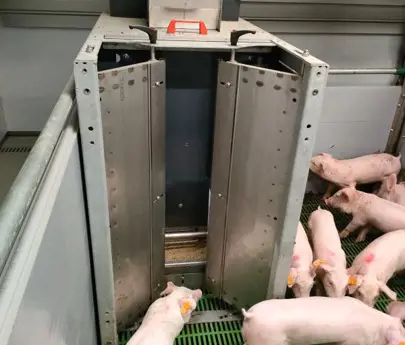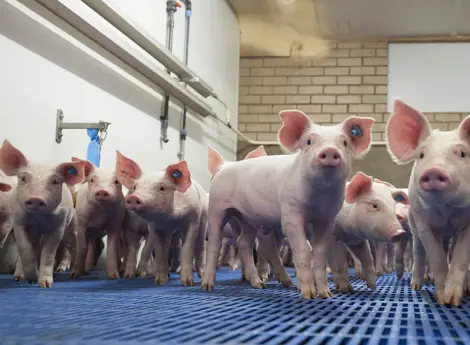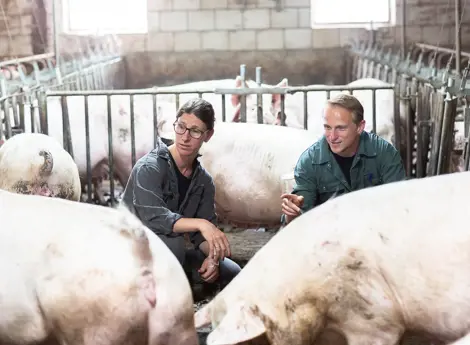Causes of thick heel joints in older piglets and finisher pigs
We are often contacted for advice on how to solve lameness in piglets and young finisher pigs. Signs for lameness are pigs with thick heel joints and pigs walking with a limp. Treatments with antibiotics often do not result in improvements. Although mortality is limited, the animal growth suffers. In some cases, the pigs become sick and have to be culled. To be able to identify the right solution an analysis what is causing these problems is required.

Abnormal positioning of the legs
In this article, we will have look at two common causes and how to address them.
With piglets that have grown fast and are housed with a somewhat heavier weight in the pig barn, especially in combination with plastic slats, the risk of piglets developing an abnormal positioning of the front legs is high. These animals stand with bent front knees. To relieve the front legs, the piglet stands with a curved back. As a result of this posture, the hind legs are heavier and incorrectly burdened with the weight since they are positioned at the wrong angle under the abdomen. Irritation often in combination with a sterile inflammation occurs on the heel joints causing swelling. This is painful and leads to a stiff gait of the piglets.
What’s the solution?
When piglets stand with their front knees bent, managing their bone quality is key. Especially phosphorous has a strong positive influence on bone quality. Increasing phosphorous in the feed can be costly and often not desired for environmental reasons. Alternative ways to manage bone quality are to increase phytase levels, make use of higher Hy-D and/or total vitamin D levels or to be careful with maximum calcium levels, due to the effect of calcium on the utilization of phosphorous.
Muscle pain
For piglets without a deviating position of the legs start to walk stiffly and develop by thick heels after arrival in the fattening unit, the cause often relates to muscle pains. This is often observed with fast-growing piglets when the temperature in the stable is too high for example during hot periods. When piglets grow rapidly they are more sensitive to blood acidification as a result of higher CO2 production. The combination of fast growing piglets under hot conditions with additional strain on the muscles during transport and replacement can lead to acidification and stiff piglets.
How to solve this?
Muscle strain related symptoms with piglets can be prevented by increasing the dietary electrolyte balance (DEB) in the feed. A higher DEB enables the pigs to deal with the acidosis more easily. By using sodium-formiate or sodium-bicarbonate we often observe a fast response of the piglets.
Nutritional measurements
In both cases, there are ways to suppress the inflammation reactions through nutrition:
- Use the right quantities and ratios of omega 3 and 6 fatty acids in the feed
- Add extra trace elements or changing the source of the trace elements
- Apply anti-oxidative substances
All of these can positively influence the blood flow- and quality of the capillaries, which has a strong supportive effect on the prevention of fluid accumulation under the skin on the joints of the piglets.
The combination of a thorough analysis, a clear approach with comprehensive nutritional advice is essential to solving these type of problems. We are happy to discuss your situation and support you with a clear and effective nutritional advice.




